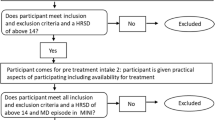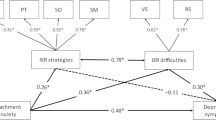Abstract
Interpersonal Psychotherapy (IPT) is an effective, pragmatic treatment for depression but interpersonal explanations of its effectiveness are not fully developed. This paper presents an integration of aspects of attachment theory and contemporary interpersonal theory which explains how interpersonal interactions contribute to a clinical understanding of depression and its treatment through IPT. We test hypotheses of interpersonal change in a case series of depressed patients treated with IPT. The results demonstrate that both attachment insecurity and interpersonal problems improve significantly over a 16 week course of treatment. Further research into the interpersonal processes that alleviate depression is needed.


Similar content being viewed by others
References
Ainsworth, M., Blehar, M., Waters, E., & Wall, S. (1978). Patterns of attachment: A psychological study of the strange situation. Hillsdale: Erlbaum.
Akiskal, H. S., & McKenney, W. T. (1975). Overview of recent research in depression: Integration of ten conceptual models into a comprehensive clinical picture. Archives of General Psychiatry, 32, 285–305.
American Psychiatric Association. (2000). Diagnostic and statistical manual of mental disorders (DSM-IV) (4th ed.). Washington, DC: American Psychiatric Association.
Barber, J. P. (1996). The role of avoidance and obsessiveness in matching patients to cognitive and interpersonal psychotherapy: Empirical findings from the treatment for depression collaborative research program. Journal of Consulting and Clinical Psychology, 64, 951–958.
Bartholomew, K., & Horowitz, L. M. (1991). Attachment styles among young adults: A test of a four-category model. Journal of Personality and Social Psychology, 61, 226–244.
Bartholomew, K., & Shaver, P. R. (1998). Methods of assessing adult attachment: Do they converge? In J. A. Simpson & W. S. Rholes (Eds.), Attachment theory and close relationships. New York: Guilford.
Beck, A. T., Steer, R. A., & Brown, G. K. (1996). Beck depression inventory manual (2nd ed.). San Antonio, TX: Psychological Corporation.
Belsky, J. (1999). Patterns of attachment in modern evolutionary perspective. In J. Cassidy & P. R. Shaver (Eds.), Handbook of attachment: Theory, research and clinical applications (pp. 141–161). New York: Guilford.
Bifulco, A., Kwon, J., Jacobs, C., Moran, P. M., Bunn, A., & Beer, N. (2006). Adult attachment style as mediator between childhood neglect/abuse and adult depression and anxiety. Social Psychiatry and Psychiatric Epidemiology, 41, 796–805.
Bifulco, A., Moran, P. M., Ball, C., & Bernazzani, O. (2002a). Adult attachment style. I: Its relationship to clinical depression. Social Psychiatry and Psychiatric Epidemiology, 37, 50–59.
Bifulco, A., Moran, P. M., Ball, C., & Lillie, A. (2002b). Adult attachment style. II: Its relationship to psychosocial depressive-vulnerability. Social Psychiatry and Psychiatric Epidemiology, 37, 60–67.
Bolton, P., Bass, J., Neugebauer, R., Verdeli, H., Clougherty, K. F., Wickramaratne, P., et al. (2003). Group interpersonal psychotherapy for depression in rural Uganda: A randomized controlled trial. JAMA: The Journal of the American Medical Association, 289, 3117–3124.
Bowlby, J. (1969). Attachment and loss: Vol. 1: Attachment. New York: Basic Books.
Bowlby, J. (1980). Attachment and loss: Vol. 3: Loss: Sadness and depression. New York: Basic Books.
Bowlby, J. (1988). A secure base. London: Routledge.
Diamond, D., Clarkin, J. F., Stovall-McClough, K. C., Levy, K., Foelsch, P., Levine, H., et al. (2003a). Patient-therapist attachment: Impact on the therapeutic process and outcome. In M. Cotina & M. Marrone (Eds.), Attachment theory and the psychoanalytic process (pp. 127–178). London: Whurr Publishers, Ltd.
Diamond, D., Stovall-McClough, K. C., Clarkin, J. F., & Levy, K. (2003b). Patient-therapist attachment in the treatment of borderline personality disorder. Bulletin of the Menninger Clinic, 67, 227–259.
Elkin, I., Shea, M. T., Watkins, J., Imber, S. D., Sotsky, S. M., Collins, J. F., et al. (1989). National Institute of Mental Health Treatment of Depression Collaborative Research Program: General effectiveness of treatment. Archives of General Psychiatry, 46, 971–983.
First, M. S., Spitzer, R. L., Gibbon, M., & Williams, J. B. W. (1995). Structured clinical interview for DSM-IV axis I disorders-patient edition (Version 2). New York: Biometric Research Institute.
Fonagy, P., Leigh, T., Steele, H., Kennedy, R., Mattoon, G., et al. (1996). The relation of attachment status, psychiatric classification, and response to psychotherapy. Journal of Consulting and Clinical Psychology., 64, 22–31.
Fraley, R. C., Waller, N. G., & Brennan, K. A. (2002). An item response theory analysis of self-report measures of adult attachment. Journal of Personality and Social Psychology, 78, 350–365.
Frank, E., Kupfer, D. J., Perel, J. M., Cornes, C., Jarrett, D. B., Mallinger, A. G., et al. (1990). Three-year outcomes for maintenance therapies in recurrent depression. Archives of General Psychiatry, 47, 1093–1099.
Frank, E., Shear, M. K., Rucci, P., Cyranowski, J. M., Endicott, J., Fagiolini, A., et al. (2000). Influence of panic-agoraphobic spectrum symptoms on treatment response in patients with recurrent major depression. The American Journal of Psychiatry, 157, 1101–1107.
Hamilton, M. (1960). A rating scale for depression. Journal of Neurology, Neurosurgery, and Psychiatry, 23, 56–62.
Hamilton, M. (1967). Development of a rating scale for primary depressive illness. British Journal of Social and Clinical Psychology, 6, 278–296.
Hesse, E. (1999). The adult attachment interview: Historical and current perspectives. In J. Cassidy & P. R. Shaver (Eds.), Handbook of attachment: Theory, research and clinical applications (1 ed., pp. 395–433). New York: Guilford Press.
Horowitz, L. M., Rosenberg, S. E., Baer, B. A., Ureno, G., & Villasenor, V. S. (1988). Inventory of Interpersonal Problems: Psychometric properties and clinical applications. Journal of Consulting and Clinical Psychology, 56, 488–460.
Joiner, T., Coyne, J. C., & Blalock, J. (1999). On the interpersonal nature of depression: Overview and synthesis. In T. Joiner & J. C. Coyne (Eds.), The interactional nature of depression: Advances in interpersonal approaches (pp. 3–19). Washington, DC: American Psychological Association.
Kiesler, D. J. (1996) Contemporary interpersonal theory & research. New York: John Wiley & Sons, Inc.
Klerman, G. L., Weissman, M. M., Rounsaville, B. J., & Chevron, E. (1984). Interpersonal psychotherapy for depression. New York: Basic Books.
Klohnen, E. C., & Bera, S. J. (1998). Behavioral and experiential patterns of avoidantly and securely attached women across adulthood: A 30-year longitudinal perspective. Journal of Personality and Social Psychology, 74, 211–223.
Krupnick, J. L., Sotsky, S. M., Simmens, S., Moyer, J., Elkin, I., Watkins, J., et al. (1996). The role of the therapeutic alliance in psychotherapy and pharmacotherapy outcome: Findings in the National Institute of Mental Health Treatment of Depression Collaborative Research Program. Journal of Consulting and Clinical Psychology, 64, 532–539.
Lesperance, F., Frasure-Smith, N., Koszycki, D., Laliberta, M. A., Swenson, J. R., Ghatavi, K., et al. (2007). Effects of citalopram and interpersonal psychotherapy on depression in patients with coronary artery disease: The Canadian Cardiac Randomized Evaluation of antidepressant and Psychotherapy Efficacy (CREATE) trial. JAMA, 297, 367–379.
Markowitz, J. C., Klerman, G. L., Clougherty, K. F., Spielman, L. A., Jacobsberg, L. B., Fishman, B., et al. (1999). Treatment of HIV-positive patients with depressive symptoms. Archives of General Psychiatry, 55, 452–457.
Markowitz, J. C., Kocsis, J. H., Bleiberg, K. L., Christos, P. J., & Sacks, M. A. (2005). Comparative trial of psychotherapy and pharmacotherapy for “pure” dysthymic patients. Journal of Affective Disorders, 89, 167–175.
Maunder, R. G., & Hunter, J. J. (2001). Attachment and psychosomatic medicine: Developmental contributions to stress and disease. Psychosomatic Medicine, 63, 556–567.
McBride, C., Atkinson, L., Quilty, L. C., & Bagby, R. M. (2006). Attachment as Moderator of treatment outcome in major depression: A randomized control trial of interpersonal psychotherapy versus cognitive behavior therapy. Journal of Consulting and Clinical Psychology, 74, 1041–1054.
McCullough, J. P. Jr (2000). Treatment for chronic depression: Cognitive behavioral analysis system of psychotherapy. New York: Guilford Press.
Mickelson, K. D., Kessler, R. C., & Shaver, P. R. (1997). Adult attachment in a nationally representative sample. Journal of Personality and Social Psychology, 73, 1092–1106.
Mufson, L., Dorta, K. P., Moreau, D., & Weissman, M. M. (2004a). Interpersonal psychotherapy for depressed adolescents (2nd ed.). New York: Guilford Press.
Mufson, L., Dorta, K. P., Moreau, D., & Weissman, M. M. (2004b). The origins and development of interpersonal psychotherapy for depression. In Interpersonal psychotherapy for depressed adolescents (2nd ed., pp. 19–29). New York: Guilford Press.
Mufson, L., Dorta, K. P., Wickramaratne, P., Nomura, Y., Olfson, M., & Weissman, M. M. (2004). A randomized effectiveness trial of interpersonal psychotherapy for depressed adolescents. Archives of General Psychiatry, 61, 577–584.
Mufson, L., Weissman, M. M., Moreau, D., & Garfinkel, R. (1999). Efficacy of interpersonal psychotherapy for depressed adolescents. Archives of General Psychiatry, 56, 573–579.
O’Hara, M. W., Stuart, S., Gorman, L. L., & Wenzel, A. (2000). Efficacy of interpersonal psychotherapy for postpartum depression. Archives of General Psychiatry, 57, 1039–1045.
Ravitz, P. (2004) The interpersonal fulcrum – interpersonal therapy for treatment of depression. CPA Bulletin, 36, 15–19.
Reynolds, C. F. III, Frank, E., Perel, J. M., Imber, S. D., Cornes, C., Miller, M. D., et al. (1999). Nortriptyline and interpersonal psychotherapy as maintenance therapies for recurrent major depression: A randomized controlled trial in patients older than fifty-nine years. JAMA, 281, 39–45.
Sibley, C. G., Fischer, R., & Liu, J. H. (2005). Reliability and validity of the revised experiences in close relationships (ECR-R) self-report measure of adult romantic attachment. Personality and Social Psychological Bulletin, 31, 1524–1536.
Stuart, S., & Robertson, M. (2003a). Interpersonal psychotherapy: A clinician’s guide. London: Arnold.
Stuart, S., & Robertson, M. (2003b). Theory and clinical applications. In Interpersonal psychotherapy: A clinician’s guide (pp. 13–34). London: Hodder Arnold.
Sullivan, H. S. (1953). The interpersonal theory of psychiatry. New York: Norton.
Travis, L. A., Bliwise, N. G., Binder, J. L., & Horne Moyer, H. L. (2001). Changes in clients’ attachment styles over the course of time-limited dynamic psychotherapy. Psychotherapy: Theory, Research, Practice, Training, 38, 149–159.
Waters, E., Merrick, S., Treboux, D., Crowell, J., & Albersheim, L. (2000). Attachment security in infancy and early adulthood: A twenty year longitudinal study. Child Development, 71, 684–689.
Weinfield, N. S., Sroufe, L. A., & Egeland, B. (2000). Attachment from infancy to early adulthood in a high-risk sample: Continuity, discontinuity, and their correlates. Child Development, 71, 695–702.
Weissman, M. M. (2006). A brief history of interpersonal psychotherapy. Psychiatric Annals, 8, 553–557.
Weissman, M. M., Markowitz, J. C., & Klerman, G. L. (2000). Comprehensive guide to interpersonal psychotherapy. New York: Basic Books.
Weissman, M. M., Markowitz, J. C., & Klerman, G. L. (2007). Clinician’s quick guide to interpersonal psychotherapy. New York: Oxford University Press.
West, M., Rose, M. S., Verhoef, M. J., Spreng, S., & Bobey, M. (1998). Anxious attachment and self-reported depressive symptomatology in women. Canadian Journal of Psychiatry, 43, 294–297.
West, M. L., & Sheldon-Kellor, A. E. (1994). Patterns of relating: An adult attachment perspective. New York: Guilford Press.
Acknowledgement
We wish to acknowledge and thank Dr. Adele Efendov, Dr. Alan Ravitz and Jasna Todorovic for their help with this manuscript.
Author information
Authors and Affiliations
Corresponding author
Rights and permissions
About this article
Cite this article
Ravitz, P., Maunder, R. & McBride, C. Attachment, Contemporary Interpersonal Theory and IPT: An Integration of Theoretical, Clinical, and Empirical Perspectives. J Contemp Psychother 38, 11–21 (2008). https://doi.org/10.1007/s10879-007-9064-y
Published:
Issue Date:
DOI: https://doi.org/10.1007/s10879-007-9064-y




